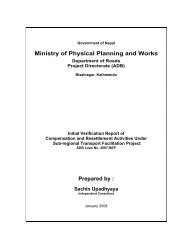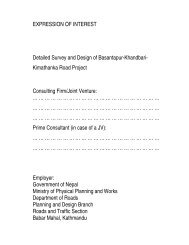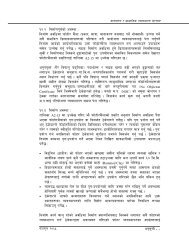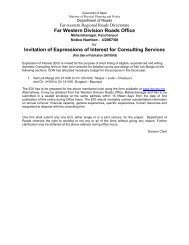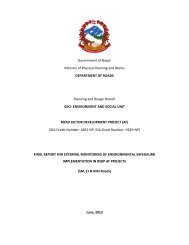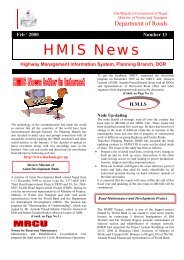Environmental & Social Management Framework - About ...
Environmental & Social Management Framework - About ...
Environmental & Social Management Framework - About ...
Create successful ePaper yourself
Turn your PDF publications into a flip-book with our unique Google optimized e-Paper software.
<strong>Environmental</strong> and <strong>Social</strong> <strong>Management</strong> <strong>Framework</strong>Chapter 55 Public Consultation <strong>Framework</strong>5.1 <strong>Social</strong> and Economic Development and Participation Issues in SRNSub-ProjectsDevelopment interventions in any road construction project, including thoseenvisaged under the SRN Program, are expected to achieve positive socialdevelopment outcomes such as increased social equity and social cohesion,empowerment, promotion of accountable and transparent governance, avoidgender discrimination as well as the mitigation of adverse impacts arising out ofthe project. Project designs are obliged to aim for sustainable environmentaldevelopment and for provisions of precautionary measures for protecting thenatural resources and the ecological functioning in the zones of project influence.As a whole the construction operation has to create positive social andenvironmental benefits in the area. In case of adverse social impacts they shouldnot fall disproportionately on the poor and vulnerable groups which worse off theircondition than they would have been without the project.Participation mechanisms facilitate the consultative process and includeinformation sharing, consultation with APs and other stakeholders, and activeinvolvement of APs in project tasks, committees, and decision-making. Thisrefers to collection of opinions from people with vested interest in the project, be itfor safeguarding and improving the living standards for local communities, be itfor ensuring best protection for the bio-physical and cultural environment. Toachieve these goals, sharing of information on all aspects appealing to aproposed project is the foremost principle of participation. In turn, the Project<strong>Management</strong> must share with the stakeholders all aspects of the envisagedproject (policies, planning, design, alternative options), and possible/anticipatedimpacts of the project) at the project identification as well as during planning andimplementation stages. To maintain social balance and confidence with the localpeople, all information needs to be disclosed to the public on the project’s likelypositive and negative impacts, the established compensation and paymentschedules, <strong>Environmental</strong> <strong>Management</strong> Action Plan (EMAP), RAP, VCDP,implementing institutions and timetable and grievances procedures.Public participation, consultation and information dissemination in a project mustbe an integral part in all environmental and social impact assessment activitiesduring the initial phases of project preparation. Concerned stakeholders will beregularly provided with information on the project prior to and during the processof IEE or EIA, respectively while the Consultants prepare the EMAP, RAP andVCDP documents as applicable.Established mechanisms of public participation include:• Contact representatives of line agencies responsible or social, economic,environmental, agriculture, forestry, land-use planning) in the project area;• Consult experienced and well-established NGOs working locally in the abovesectors;• Consult researchers working in the said areas;April 2007 Chapter 5-1



![j:6 ]zg cfof ]hgf](https://img.yumpu.com/51286794/1/190x245/j6-zg-cfof-hgf.jpg?quality=85)

![x'nfsL /fhdfu { cfof ]hgf](https://img.yumpu.com/50581959/1/190x245/xnfsl-fhdfu-cfof-hgf.jpg?quality=85)
